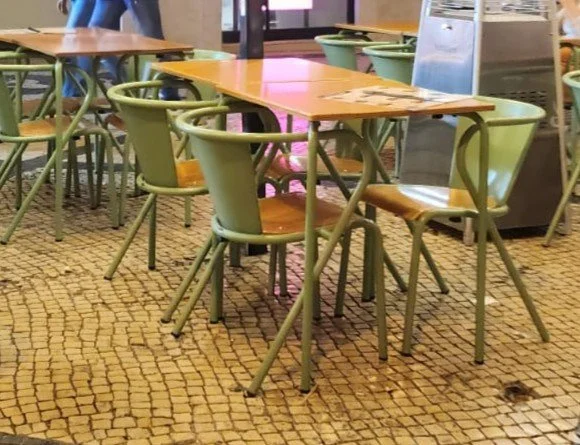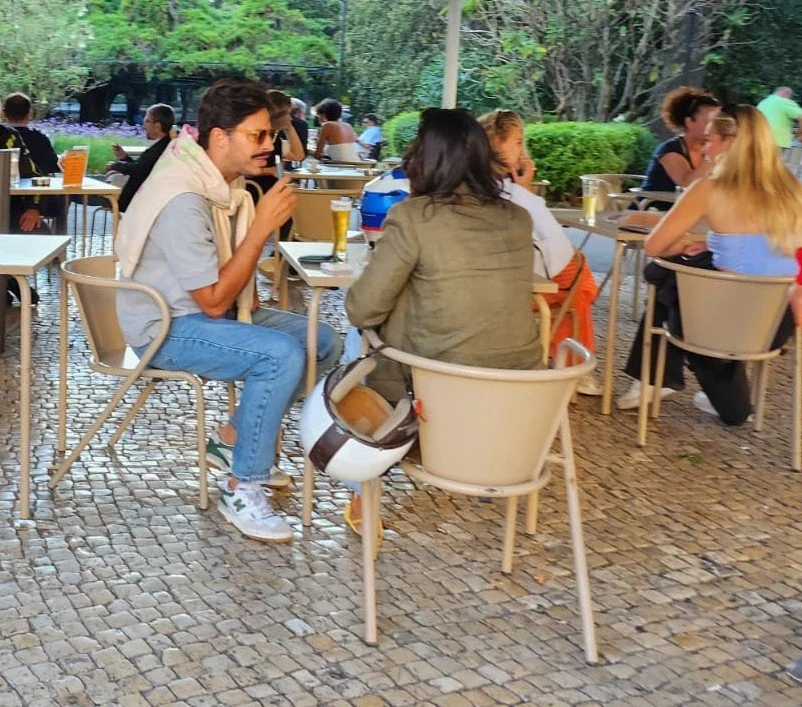The Portuguese Chair
Last autumn, I was intrigued by this chair that seemed to populate every restaurant and café terrace in Lisbon. Scattered across cobblestone streets, under striped awnings and along sunlit squares. It appeared in every shade imaginable – from deep burgundy to soft taupe – its finish ranging from glossy to matt. Some were pristine, freshly painted; others were chipped, their metal frames bearing the patina of years under the Lisbon sun. If anything could be called an icon of the city, this chair surely was. As I watched a waiter effortlessly stack five of them, the metal legs clattering as he trolleyed them across the street. The tower of chair moved steadily, like a dignified gentleman navigating the bustle of commuters. I wondered who designed this incredibly versatile chair?The original is often attributed to a master metal craftsman Gonçalo Rodrigues dos Santos who worked at the Arcalo store along Rua Alegre in 1940s. Arcalo specialised in metal components - clamps for machine belts and heels for woman’s shoes- but it was Gonçalo who bent two simple curvilinear tubes into existence, creating a chair that would outlive generations. One tube formed the backrest and rear legs and the other the seat and front legs, crafted with a bending tool invented by Gonçalo himself. By the 1950s, this chair has become an inseparable part of Lisbon’s streetscape. It lined pastelería where locals sipped bica and read morning newspaper, and stood resilient through the seasons. L to R: 1956 Esplanade of the Cross of Olives photographed by Armano Maia Serôdio, Arcalo factory and Manuel Caldas welding the Gonçalo chair
Decades later, a former Arcalo worker, Manuel Caldas revived the company, securing the trademark in 1997. The Gonçalo chair was reintroduced at the 1998 Lisbon World’s Fair Exposition and has been in production ever since. Today, his son, Alexandre Caldas carries on the legacy. Working alongside Master Serafim (one of Gonçalo's apprentices) Alexandre launched his own brand, AroundtheTree in 2013. His Portugese Roots Chair, a wooden reinterpretation of the classic metal design won a silver award from the A’Design Awards and was exhibited in the Museum of Design and Fashion (MUDE). In 2020, Alexandre further internationalised the chair with the BICAchair brand, making it both collectible and accessible. But the story doesn’t end here. Another metal furniture manufacturer, Adico lays claim to the Portugese café chair with its model 5008, which has been in production since the 1930s. In 2016, designer Pedro Sottomayor collaborated with Adico to create the Maria and Manel chairs in compliance with new city regulations to rejuvenate the city with the Gonçalo chair. The new chairs adopted a similar metal frame but were made much lighter with aluminium and a hole punched in the seat to drain rainwater. L to R: Portuguese Roots Chair by Alexandre Caldas, Bica Chair, Manel Chair by Pedro Sottomayor, Adico 5008
Despite debates over its true origins, whether it is made by Arcalo or Adico, called the BICA chair or Gonçalo chair, it’s ubiquity in Lisbon tells its own story. More than a product of industrialisation, the icon is an artefact of everyday life, shaped by those who use it, adapt it and make it their own. The chair has endured across generations, not because of a single creator, but through continuous reinvention by many. An object becomes an icon when replicated and embedded into the identity of a place, becoming part of the city's collective memory.










